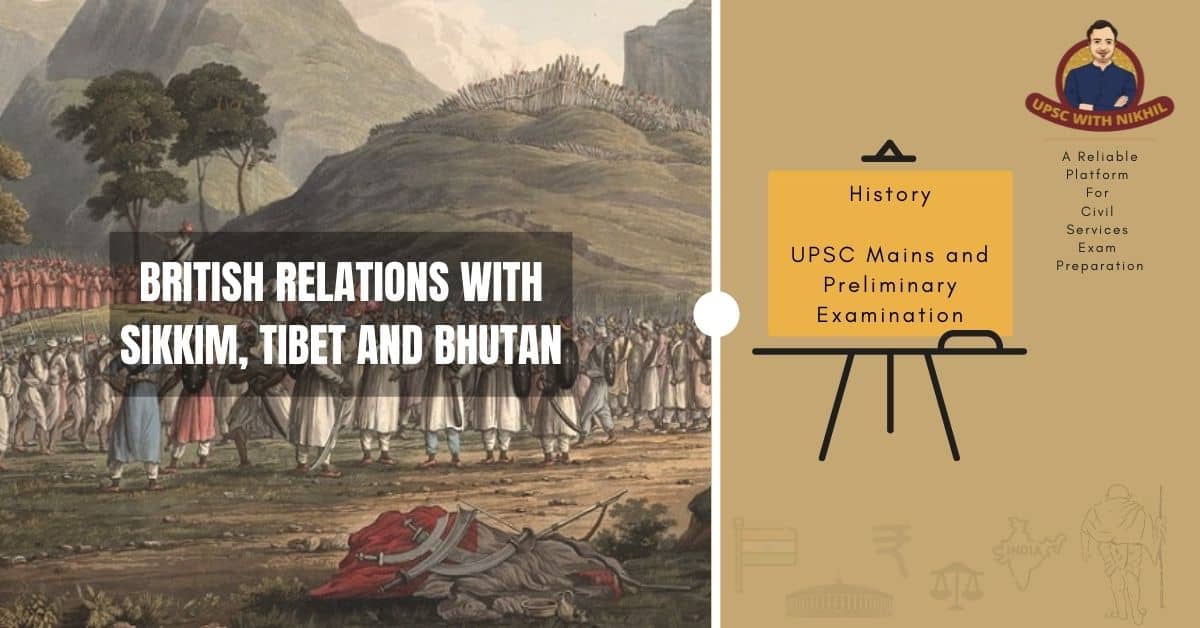British Relations With Sikkim, Tibet And Bhutan
RELATIONS WITH SIKKIM
Sikkim is located to the north of Bengal, adjacent to Nepal, and on the Tibetan-Indian border. In exchange for an annual monetary grant, the Raja of Sikkim ceded to the British territory around Darjeeling in 1835. Friendly relations between the British and the Raja (of Sikkim) were strained in 1849 when Dalhousie dispatched troops to Sikkim, whose ruler was forced to cede nearly 1700 square miles of his territory to British India as a result of a minor quarrel. The second clash occurred in 1860, when the British were attacked by the Diwan of Sikkim's troops.
• Sikkim was reduced to the status of a virtual protectorate by the 1861 peace treaty.
• The Raja of Sikkim expelled the Diwan and his family from the state, agreed to pay a fine of Rs. 7,000 and full compensation for British losses in the war, fully opened his country to British trade, and agreed to limit the transit duty on goods traded between India and Tibet via Sikkim.
• In 1886, new trouble arose when Tibetans attempted to annex Sikkim with the help of pro-Tibet rulers. The Indian government, on the other hand, would not allow this to happen.
• It saw Sikkim as a vital buffer for the security of India's northern frontier, particularly Darjeeling and its tea-growing regions. As a result, in 1888, the British launched military operations against the Tibetans in Sikkim.
• In 1890, an Anglo-Chinese agreement was signed, bringing an end to the conflict. The treaty recognised Sikkim as a British protectorate, with the Indian government having exclusive control over its internal administration and foreign relations.

RELATIONS WITH TIBET
Tibet is located to the north of India, separated from India by the Himalayan peaks. The local population had been reduced to serfdom and even slavery by a Buddhist religious aristocracy (the Lamas). The Dalai Lama, who claimed to be the living embodiment of the Buddha's power, wielded the most political power. The lamas wanted to isolate Tibet from the rest of the world; however, Tibet had recognised the Chinese Empire's nominal suzerainty since the early 17th century. The Chinese government also discouraged contacts with India, despite the fact that there was some trade and pilgrimage between India and Tibet.
• During the 19th century, the Chinese Empire, which was ruled by the Manchu monarchy, began to decline. Britain, France, Russia, Germany, Japan, and the United States of America gradually penetrated China on a commercial and political level, gaining indirect political control over the Manchus in the process.
• At the end of the 19th century, the Chinese people created a powerful anti-Manchu and anti-imperialist nationalist movement, and the Manchus were overthrown in 1911.
• However, the nationalists led by Dr. Sun Yat Sen were unable to consolidate their power, and China was torn apart by civil war over the following years.
• As a result, China has been unable to assert even nominal control over Tibet since the mid-nineteenth century. The Tibetan authorities continued to acknowledge Chinese over lordship in theory so that other foreign powers would not be enticed to invade Tibet. Tibet, on the other hand, could not maintain its complete isolation for long. Both the United Kingdom and Russia were eager to strengthen ties with Tibet. Both economic and political considerations guided Britain's policy toward Tibet.
• From an economic standpoint, the British wanted to expand Indo-Tibetan trade and exploit the country's abundant mineral resources.
• From a political standpoint, the British wanted to protect India's northern border. However, the Tibetan authorities resisted all British attempts to penetrate the country until the end of the nineteenth century.
• At the same time, Russia's attention was drawn to Tibet. The British government would not tolerate an increase in Russian influence in Tibet.
• The Indian government, led by Load Curzon, a zealous empire builder, decided to act quickly to counter Russian moves and bring Tibet into its system of protected Border States.
• According to some historians, the Russian threat was fabricated by Curzon to justify his intervention in Tibet. In March 1904, Curzon dispatched a military expedition led by Francis Younghusband to Lhasa, Tibet's capital. The Tibetans, who were largely unarmed and lacked modern weapons, fought back valiantly but unsuccessfully.
• The expedition arrived in Lhasa in August 1904 without encountering any Russians along the way. After lengthy negotiations, a treaty was signed.
• Tibet was required to pay a compensation of Rs. 25 lakhs; the British were to occupy the Chumbi valley for three years; and a British trade mission was to be stationed in Gyantse.
• The British agreed to refrain from meddling in Tibet's internal affairs. Tibet's Tibetans agreed not to allow representatives of any foreign power into the country.
• The Tibetan expedition yielded very little for the British. It ensured Russia's withdrawal from Tibet, but at the expense of confirming Chinese dominance.
RELATIONS WITH BHUTAN
Bhutan is a large hilly country to the east of Sikkim and on India's northern border (as depicted in the map below – red line). After 1774, when Bhutan allowed Bengal to trade with Tibet through its territory, Warren Hastings established friendly relations with the ruler of Bhutan.
• After 1815, relations between India's government and Bhutan's government deteriorated. The British began to look with greedy eyes at the 1,000-square-mile strip of land at the base of the Bhutanese hills, which contained a number of duars or passes.
• This region would provide India with a well-defined and defendable border as well as valuable tea-growing lands for British planters.
• Lord Auckland annexed the Assam duars in 1841. Intermittent raids by the Bhutiyas (a tribal group) on the Bengal side of the border further strained relations between India and Bhutan.
• A brief war between the British and Bhutan erupted in 1865. The fighting was completely one-sided, and a treaty was signed in November 1865 to end it.


